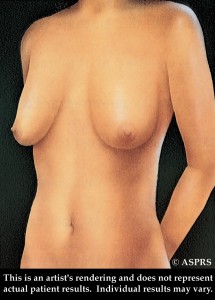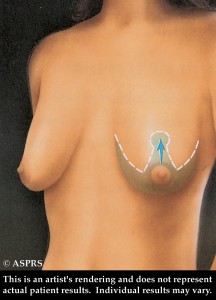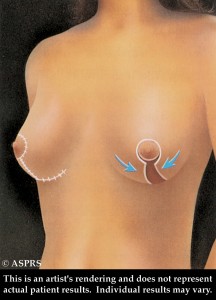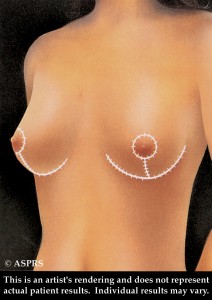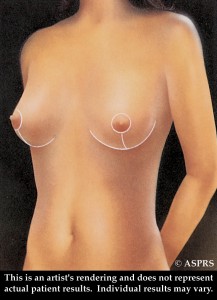INTRODUCTION
With increasing age, following pregnancy or after significant weight loss, the breasts may lose their tone and feel deflated, causing the breast silhouette of youth to be lost. Normally, the distance measured from the sternal notch (the hollow at the base of the neck) to the nipple lies around 21 to 23 centimetres. If the breasts feel deflated but the nipple distance remains within normal, then a breast augmentation may be needed. When the breasts lose their tone along with an increase in nipple distance, the treatment for this problem becomes what is known as a mastopexy. On occasion, both a mastopexy and a breast augmentation are needed if the breasts are very empty and the nipples very low.
AM I A CANDIDATE FOR THIS SURGERY?
All women in good health are candidates for this intervention. If the breasts appear flaccid and low, then you should consult a well-qualified plastic surgeon for advice. Age is not a factor, only health status.
PROCEDURE
The surgery can be performed under general anaesthesia or with sedation. A keyhole-shaped excision of skin is made around the nipple. The nipple is then raised to the circular part of the keyhole and the ‘arms’ of the keyhole are wrapped underneath the nipple. After closing all the incisions lines, the resulting scar takes the shape of an anchor whose horizontal part lies underneath the breast mound.
PREPARATION BEFORE SURGERY
Aspirin and all anti-inflammatory medication should not be taken for three weeks before surgery until two weeks after surgery. Anti-inflammatory medication and Aspirin causes thinning of the blood and may lead to excess bleeding during and after surgery. Tylenol (Acetaminophen), however, does not cause this problem and may be taken without problems.
Alcohol in any form is not to be consumed for two weeks before surgery until two weeks after surgery. Alcohol has properties that dilate blood vessels and thin the blood and can contribute to excessive bleeding during and after surgery. Even a small amount can cause problems.
Cigarette smoking and nicotine intake in any form is strictly banned for the period of one month before surgery until one month after surgery. Cigarettes and nicotine contains properties that diminish oxygenation of skin and other tissues and can contribute to skin necrosis (see below).
Should you have regular medications to take, ask your surgeon if you should take them before surgery or not. Certain medications can cause problems and only your surgeon can determine this.
AFTER SURGERY
You will have a dressing that will be removed by your surgeon 3 or 4 days after surgery. He may require you to wear a bra for 3 weeks day and night after surgery, only to be removed for showers.
Excessive physical activities should avoided, especially those that require the use of your arms. Excess activity can lead to suture rupture, swelling or bleeding after surgery. You should be able to progressively return to normal activities after about 3 weeks and by 6 weeks all activities can be normalised.
Avoid breast manipulation for 4 to 6 weeks
POSSIBLE COMPLICATIONS
Possible ComplicationsCONCLUSION
The low, sagging breast often seen after weight loss, pregnancy or with increasing age may be managed with a mastopexy procedure with or without a breast augmentation. With this, the breast silhouette of youth may be regained along with the feminine confidence that comes with it.
FAQ Regarding Breast Surgery
After pregnancy, my breasts have changed. What surgery do I need to give me back what I had?
This is a very good question, but with different possible answers depending on what your physical exam shows. Pregnancy and breast-feeding can often result in a ‘deflated’ breast, which can be demoralizing.
- If the nipple-areola region is pointing toward your toes when you stand up, then it is probable that you need a mastopexy (aka ‘breast-lift’).
- If the nipple region points more-or-less in a forward direction, then you could get away with only a breast augmentation.
- Other times, you may need both a mastopexy and a breast lift, but it all depends on what is found during the physical exam.
I am confused about all the different breast implants out there. Can you clarify this for me?
There are essentially 3 general categories of breast implants: saline-filled implants, silicone-gel implants and cohesive-gel implants. All 3 are made of silicone, a substance which can be made liquid (like molasses), semi-solid (like a gummy bear) or quite hard (like a car tire).
Saline-filled implants are essentially a hard silicone rubber balloon that is filled with saline solution during the surgery. Because the saline solution can easily create waves with motion, these implants are placed behind the muscle so that the waves and ripples are less visible. Also, since this is essentially a balloon, the implants can leak and deflate.
Silicone-gel implants are made of a silicone rubber shell pre-filled with a more liquid silicone. These implants do not produce waves or ripples as much as saline, and can be placed either above or behind the muscle. They can, however, leak and the liquid silicone can spread outside the confines of the implant when this happens. They also are more prone to forming implant capsules.
Cohesive-gel implants are made of a rubbery silicone exterior shell filled with a slightly less rubbery silicone interior, somewhat resembling a Gummy Bear in consistency. Because of this property, they do not leak, but they have to be pre-shaped during production. They can also be placed above or below the muscle since there is very little rippling. They are technically more challenging to use since the surgeon needs to have a good eye to choose the right implant for each patient. The results, however, are the most natural. Dr Hashim has extensive experience with anatomic implants and he is an internationally recognized expert in their use.
My friend told me that implants are better under the muscle. Is this true?
No. Your breasts sit on top of the muscle, so the most natural result is to have an implant above the muscle. There is no inherent beauty in placing an implant underneath the muscle and the only reason to place them in this position is to hide the limitations of the implant. For example, a saline-filled implant may show waves and rippling through the skin if they are placed on top of the muscle. If someone is very thin, then the implant may show too much. It also depends on the type of implant. Silicone-filled implants are more prone to noticeable capsule formation on top of the muscle, so it may be better underneath. However, cohesive-gel implants that are anatomic in shape look very good on top of the muscle and it is the preferred position by Dr Hashim.
You should be aware that implants that are placed underneath the muscle may get displaced with muscle contraction, so if you are very physically active, you should seek a surgeon who is able to use anatomic cohesive-gel implants on top of the muscle.
Can I have a breast-lift and augmentation at the same time?
Dr Hashim prefers to separate these surgeries to get the best result possible and perhaps save you some time and money! During your consultation with him, Dr Hashim will determine which surgery is best to start with.
Often, the treatment starts with a breast augmentation and depending on the state of your breasts, it may be enough, and not require a second stage breast-lift, which would save you time, money and scars! We estimate that 90% of patients do not need to go on to a breast lift after an augmentation.
Similarly, he may start with a breast-lift and see if a second stage augmentation is required or not. This would depend on the actually mass of breast tissue available during the lift.
Can I have breast surgery at the same time as a tummy-tuck?
Absolutely!
Do I need to change my breast implants after a certain period?
There is no ‘expiry date’ when you have to exchange implants. Implants are exchanged only when needed, such as a leaky implant or a bothersome capsule that has formed around the implant. Saline implants generally last at least 10 years, and cohesive-gel implants can last much longer.

